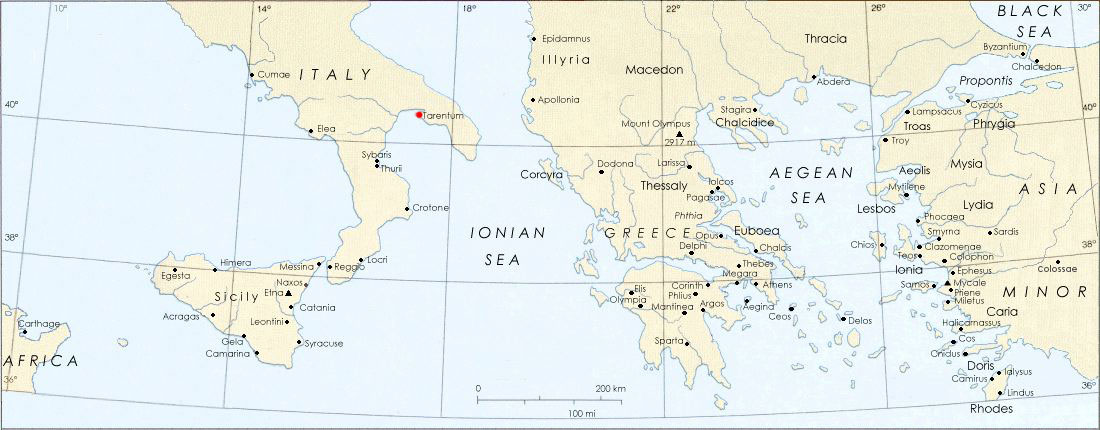Now Taranto; a Greek city on the western coast of Calabria in Italy with an excellent harbour, which formed a part of the Sinus Tarentinus. The surrounding country was both fertile and picturesque. Tarentum was traditionally said to have been built by the Iapygians, mingled with colonists from Crete, and to have derived its name from Taras, a son of Poseidon (Pausan. x. 10, 6). Its importance dates from the year B.C. 708, when it was captured by a body of Lacedaemonians under Phalanthus (see the article Partheniae), after which it became a flourishing place, holding a sort of suzerainty over the rest of the cities of Magna Graecia. Its commerce was extensive; it had a powerful fleet; and could bring into the field an army of 30,000 infantry and 3000 cavalry, including the forces of its allies; its own troops numbered 22,000 men.Its government was different at different periods of its history. At the time of Darius Hystaspis it was ruled by kings; but later it became a democracy. Its later law-code was the work of Archytas, who flourished about B.C. 400. As its wealth increased, its people became luxurious and effeminate; and being attacked by the neighbouring Lucanians, it appealed to Sparta for help. In answer to this appeal Archidamus, son of AgesilaŘs, came to their assistance in B.C. 338; and he fell in battle fighting on their behalf. The next prince whom they invited to succour them was Alexander, king of Epirus, and uncle to Alexander the Great. At first he met with considerable success, but was eventually defeated and slain by the Bruttii in 326 near Pandosia on the banks of the Acheron. Shortly afterwards the Tarentines had to encounter a still more formidable enemy. Having attacked some Roman ships, and then grossly insulted the Roman ambassadors who had been sent to demand reparation, war was declared against the city by the powerful Republic. The Tarentines were saved for a time by Pyrrhus, king of Epirus (see Pyrrhus), who came to their help in 281; but two years after the defeat of this monarch and his withdrawal from Italy, the city was taken by the Romans (272). In the Second Punic War Tarentum revolted from Rome to Hannibal (212); but it was retaken by the Romans in 207. and was treated by them with great severity, From this time Tarentum declined in prosperity and wealth. It was subsequently made a Roman colony, and it still continued to be a place of considerable importance in the time of Augustus ( Tac. Ann.i. 10). Its inhabitants retained their love of luxury and ease; and it is described by Horace as molle Tarentum and imbelle Tarentum. Even after the downfall of the Western Empire the Greek language was still spoken at Tarentum; and it was long one of the chief strongholds of the Byzantine Empire in the south of Italy. [p. 1525]
The town of Tarentum consisted of two parts, viz.: a peninsula or island at the entrance of the harbour, and a town on the mainland, which was connected with the island by means of a bridge. On the northwest corner of the island, close to the entrance of the harbour, was the citadel: the principal part of the town was situated southwest of the isthmus. The modern town is confined to the island or peninsula on which the citadel stood. The neighbourhood of Tarentum produced the best wool in all Italy, and was also celebrated for its excellent wine, figs, pears, and other fruits. Its purple dye was also much valued in antiquity. (Harpers Dictionary of Classical Antiquities, 1898)
